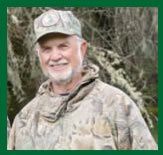Spring Turkey Rundown
by Terry Knight
The California Spring turkey season gets underway on March
27. There is a special youth hunt on Mar. 20-21 and an archery
only season from May 2 through May 16.  The shooting hours
are one-half hour before sunrise to 4 p.m. and the limit is one
bearded turkey per day and a total of three for the season per
licensed hunter. (W.U. bag limits on W.U. properties are of
course different.) A bearded turkey is classed as one where the
beard protrudes from the breast and can be seen. Actually the
turkey can be either a tom or a hen as long as it has a visible
beard. However, hunters are encouraged not to shoot the hens.
The average tom will weigh from 8 to 20 pounds.
The shooting hours
are one-half hour before sunrise to 4 p.m. and the limit is one
bearded turkey per day and a total of three for the season per
licensed hunter. (W.U. bag limits on W.U. properties are of
course different.) A bearded turkey is classed as one where the
beard protrudes from the breast and can be seen. Actually the
turkey can be either a tom or a hen as long as it has a visible
beard. However, hunters are encouraged not to shoot the hens.
The average tom will weigh from 8 to 20 pounds.
As expected, the state is literally awash with wild turkeys. In fact, wild turkeys can be found on both private and public lands from the Mexican border to Oregon. Actually in many areas they have become pests.
California has three species of wild turkeys with the most common being the Rio Grande. These are the turkeys you see around the local farms and houses. The Merriam turkey is a high country bird and is normally found at elevations above 5,000 feet. The other species is the Eastern which is found in limited numbers along the North Coast. All three species will interbreed where their ranges cross.
Knowing turkey behavior can mean the difference between success and failure when it comes to the hunting bird. Wild turkeys always roost in trees. A flock will establish a pattern where they feed and roost. Typically a flock of turkeys will select several trees for roost trees and unless spooked will return to these same trees day-after-day. Turkeys will fly up to the roost tree just before dark and stay there until daylight. Typically, several toms will roost in one tree and the hens will roost in a nearby tree. Any unusual noise will cause the toms to gobble from the tree. Hunters can use this trait to their advantage in locating a roost tree. One of the best methods is to get up on a ridge before daylight and blow on a crow call.
If a tom is within hearing distance, chances are that he will gobble back. I have had toms gobble to a crow call from up to a mile away.
At daylight the toms will start to gobble to attract hens. Often you will hear a gobble followed by the yelp of a nearby hen. The more the hen yelps the more excited the tom will get. At times he will gobble nearly nonstop at the hens. At first light the hens will fly down and walk to the roost tree that is holding the toms. The toms will immediately join them. Other times the hens will make a long flight from the roost tree and land in an open glade. The toms will fly down to them and start to strut. Strutting in one method that toms use to attract a hen.
If you can locate a roost tree before daylight you should set up within about 100 yards from the tree. Either use a blind or sit against a tree and remain perfectly still. If you have a decoy, set it out about 25 yards from you. Once the toms are on the ground give a couple of soft clucks with your call. The tom should answer with a loud gobble. Once the tom starts gobbling, call only enough to keep him interested in you and if he starts towards you, quit calling. He already has you located and he will often come in on the run or walk towards you in a full strut. When he gets within the 30-yard mark, aim at the base his neck and fire. If he goes down, immediately run to the flopping turkey and place your foot on his neck. More than one hunter has seen a turkey suddenly recover and run off.
If you don’t score in the morning, walk the ridges and make a series of loud yelps. Often you will get a gobble in response. If you do hear a gobble, immediately find cover and set up. Turkeys are most active right after daylight and late in the afternoons. During the middle of the day they will often stay tight and rest.
W.U. hunters often ask which ranches offer the best hunting. That can change from week-to-week. If turkey hunting is allowed on a ranch there are a sufficient number of birds on that ranch to hunt. Hunting turkeys is also a learning process and the longer you hunt the better hunter you will be. Not even the best hunters are successful every year. The key to success is patience.
Few types of hunting is as rewarding as turkey hunting. It can be nerve wracking when you hear that loud gobble and the fun of turkey hunting is not just shooting the bird but calling him in.
